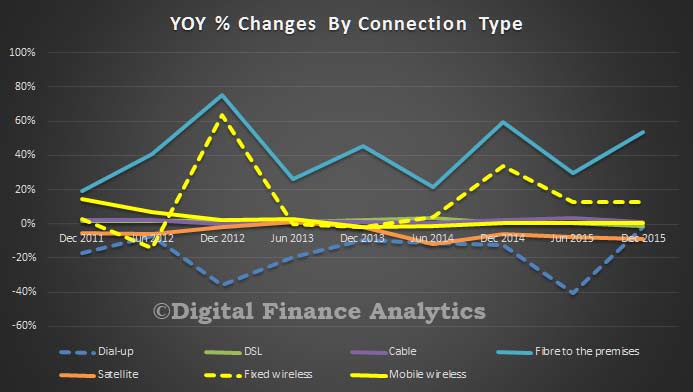The latest internet activity data from the ABS, to December 2015, shows that both internet speeds and data usage continue to rise. There were approximately 12.9 million internet subscribers in Australia at the end of December 2015. This is an increase of 2% from the end of December 2014. As at 31 December 2015, almost all (99.3%) internet connections were broadband. Fibre continues to be the fastest growing type of internet connection in both percentage terms and subscriber numbers. The number of fibre connections doubled between December 2014 and December 2015 to 645,000 subscribers.
Around half of all internet connections are via a mobile device. DSL has more than 40%, and fibre to the premises is now beginning to register strongly (thanks to NBN roll out).
 The year on year changes show that fibre 6 month by 6 month growth is above 50%, making an annual rise of more than 100%. Most other channels were relatively static.
The year on year changes show that fibre 6 month by 6 month growth is above 50%, making an annual rise of more than 100%. Most other channels were relatively static.
 A large number of users now have advertised download speeds of more than 8Mbps – 80% of users in Dec 2015. Close to 20% are between 1.5Mbps and 8Mbps. The ABS does not break out the figures by geographic regions. We think they should. Also, of course, advertised speed and actual speeds delivered are two different things. Data from our digital channels survey indicates that more than half of households experience data rates well below advertised speeds. Those in regional and rural areas had the worst experiences, but we also see a rise in below par speeds in urban areas as service demand rises faster than capacity investment. Slow real speeds have been discussed recently on QandA. Buffering… Buffering….!
A large number of users now have advertised download speeds of more than 8Mbps – 80% of users in Dec 2015. Close to 20% are between 1.5Mbps and 8Mbps. The ABS does not break out the figures by geographic regions. We think they should. Also, of course, advertised speed and actual speeds delivered are two different things. Data from our digital channels survey indicates that more than half of households experience data rates well below advertised speeds. Those in regional and rural areas had the worst experiences, but we also see a rise in below par speeds in urban areas as service demand rises faster than capacity investment. Slow real speeds have been discussed recently on QandA. Buffering… Buffering….!
For perspective, read this earlier post. We continue to slip down the global rankings. In the report published by Akamai Technologies, Australia fell to 48th place in a global average broadband connection speeds. The report says the average broadband speed for Australia in the fourth quarter of 2015 was 8.2Mbps, down from 46th place when compared to the rest of the world. In terms of average peak internet speeds, at 39.3Mbps, Australia fared badly, dropping to 60th position (down from 46th) in the quarter. This despite Australia’s average and peak internet speeds having increased by 11 per cent and 6.4 per cent year-on-year, respectively.
 National data consumption has continue to climb, especially via fixed line broadband. To December 2015, this rose to more than 1,600,000 TBs. The average wireless mobile user consumed around 7gb whilst the average fixed line user consumed close to 250gb. Streaming media services account for a significant proportion of the rise from around 200gb in June 2015.
National data consumption has continue to climb, especially via fixed line broadband. To December 2015, this rose to more than 1,600,000 TBs. The average wireless mobile user consumed around 7gb whilst the average fixed line user consumed close to 250gb. Streaming media services account for a significant proportion of the rise from around 200gb in June 2015.

